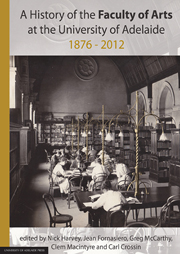Book contents
- Frontmatter
- Contents
- List of Contributors
- 1 The Faculty of Humanities and Social Sciences and the BA Degree at the University of Adelaide since 1876
- 2 Webs of Significance: an Ethnographer's Account of Anthropology at the University of Adelaide from 1973 to 2011
- 3 The History of the Centre for Asian Studies at the University of Adelaide
- 4 Classics at the University of Adelaide (1874–2012)
- 5 English and Creative Writing: ‘the abode of … literature; the home of poetry and fiction’
- 6 A Tale of Resilience: the History of Modern European Languages at the University of Adelaide
- 7 Geography, Environment and Population at the University of Adelaide, 1904–2012
- 8 Gender Studies and Social Analysis
- 9 History
- 10 The History of Aboriginal Languages and Linguistics at the University of Adelaide
- 11 The Digital, Participatory and International Turn: Media at the University of Adelaide
- 12 Musical fusions
- 13 Philosophy at the University of Adelaide
- 14 Politics at the University of Adelaide
- Appendices
9 - History
Published online by Cambridge University Press: 05 June 2013
- Frontmatter
- Contents
- List of Contributors
- 1 The Faculty of Humanities and Social Sciences and the BA Degree at the University of Adelaide since 1876
- 2 Webs of Significance: an Ethnographer's Account of Anthropology at the University of Adelaide from 1973 to 2011
- 3 The History of the Centre for Asian Studies at the University of Adelaide
- 4 Classics at the University of Adelaide (1874–2012)
- 5 English and Creative Writing: ‘the abode of … literature; the home of poetry and fiction’
- 6 A Tale of Resilience: the History of Modern European Languages at the University of Adelaide
- 7 Geography, Environment and Population at the University of Adelaide, 1904–2012
- 8 Gender Studies and Social Analysis
- 9 History
- 10 The History of Aboriginal Languages and Linguistics at the University of Adelaide
- 11 The Digital, Participatory and International Turn: Media at the University of Adelaide
- 12 Musical fusions
- 13 Philosophy at the University of Adelaide
- 14 Politics at the University of Adelaide
- Appendices
Summary
INTRODUCTION
This summary history of History at Adelaide is divided into three parts. The first surveys the faltering initial attempts to establish ‘modern history’ in the curriculum, and the subsequent half-century when the subject was effectively embodied by a single professor. In these early days, history was still a relative newcomer on the academic scene. Some post-classical history had been part of the upstart London University's BA degree from the 1830s, but modern (as distinct from Greek and Roman) history barely managed to squeeze into the formal undergraduate curriculum at Oxford and Cambridge before the 1850s. When the University of Adelaide was founded a quarter-century later, the abolition of convict transportation to NSW and Victoria had combined with the legacy of the gold rushes to ensure that South Australia would remain significantly less populous and prosperous than those eastern colonies.
South Australia's first university did not establish a chair in modern history until 1900, ten years after Sydney and more than four decades on from the first classes in that subject at the University of Melbourne. Yet until the latter end of the twentieth century Adelaide's standing in the field bore favourable comparison with its better resourced and larger eastern counterparts. A series of outstanding professorial appointments culminated in that of Hugh Stretton, who built up what came to be one of Australia's liveliest and most innovative history departments. The second part of this chapter traces the changing fortunes of the Stretton era, from 1954 to 1989.
- Type
- Chapter
- Information
- A History of the Faculty of Arts at the University of Adelaide1876-2012, pp. 235 - 264Publisher: The University of Adelaide PressPrint publication year: 2012
- 1
- Cited by



